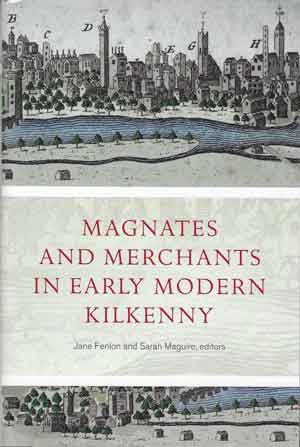
JANE FENLON and SARAH MAGUIRE
Four Courts Press
€50
ISBN 9781801510899
Reviewed by Eoin Swithin Walsh
Eoin Swithin Walsh is the author of Kilkenny: in times of revolution, 1900–1923 (Merrion Press, 2018).
One of the significant successes of the ‘decade of centenaries’ has been the upsurge of interest in local histories. Knowing what happened in one’s own town or village in the past often appeals more to the general reader than a national history. Hopefully, this renewed interest in local history will now extend to previous centuries, and this publication is a very good place to start.
Originating from a study day and exhibition held in Kilkenny Castle in 2019, the book is divided into a number of essays by specialists in their respective fields: Linda Doran, Julian Munby, David Edwards, Danielle O’Donovan, Oliver Harris, Bríd McGrath and Jane Fenlon (who edited along with Sarah Maguire). The expertise of these contributors is much wider than in the usual history publication, with architectural historians, art historians and historical geographers in the mix.
Kilkenny was the largest and wealthiest inland town in Tudor Ireland. Much has been written about the Butlers of Ormonde, with their seat in Kilkenny Castle. This publication, however, is anchored around those below them on the social ladder, i.e. the élite merchant families in Kilkenny during the 1500s—the Shees, Rothes, Archers, Whites, Cowleys and Langtons—who worked in a symbiotic relationship with the Earls of Ormonde; one side could not prosper without the other. The result was that the sixteenth century could be seen as a golden age for Kilkenny, especially in terms of its trade and architecture. For instance, the Continental-inspired stone arcades—located in front of merchants’ premises, as can still be seen in present-day Rothe House—are considered unique to Kilkenny in an Irish context.
The scope of the book is also much wider than the title suggests. Earlier and later centuries are incorporated in some detail to give background context and a postscript to the lives of these merchant families. For example, Bríd McGrath’s engaging essay focuses on the Kilkenny merchant families in the 1613–15 parliament. Nor is it wholly Kilkenny-focused; comparisons are made with surrounding towns, other parts of Ireland and even Britain. The latter includes Kilkenny’s surprising association with the important trading port of Bristol. In addition, Linda Doran looks at neighbouring New Ross, Co. Wexford, founded by William Marshall, who had married Strongbow’s daughter Isabel, ‘the second richest heiress in England’. He essentially built New Ross to act as a private trading port for Kilkenny and his lands along the rivers Nore and Barrow. This was an attempt to bypass the established royal port of Waterford, much to the latter’s consternation.
David Edwards’s lively essay depicts the vast complexities and competing dynamics of sixteenth-century Kilkenny. The scramble by different wings of the Butler family to ‘win’ the earldom of Ormonde from an heirless absentee uncle is fascinating in itself. The narrative includes tales of murder, death by food poisoning, kidnapping and hostage exchange. It acts as a reminder that the power of the ‘old Gaelic’ families on Kilkenny’s borders had not waned, with merchants often acting as go-betweens. Danielle O’Donovan’s treatment of Margaret Butler, Countess of Ormonde, makes for fascinating reading. In many respects she was the brains behind her husband’s victory in securing the earldom. She also founded a school in Kilkenny, which educated the children of the merchant ‘servant’ class, thus securing both Ormonde control and the future prospects of the offspring of the merchant families. Arguably the couple’s greatest legacy was their patronage of ‘tomb sculpture’, something that can still be appreciated today, with this reader having gained a new-found appreciation of this art form and those who sculpted it.
One minor gripe is the absence of explanation of the more technical terminology, especially for those not au fait with this era of history or architecture. For example, terms like ‘mensa’, ‘punch dressing’, ‘atelier’ or ‘overhanging crocketed pinnacle’ deserved a brief description—at least in the footnotes—which would greatly aid the more casual reader. Having said that, this book is perfect for budding historians or students of late medieval/Tudor Ireland. The essays usually include a historiography of the sources, while of enormous benefit is the placing of footnotes at the bottom of each page rather than in an endnote section. At a glance, one can see the source of a quote from 500 years ago, without having to trawl through the back pages. The wills of the merchant families are a particularly interesting primary source. Four Courts Press have also given the book a luscious presentation. Images are dispersed throughout, rather than in a central plates section. This is extremely beneficial, as many of the essays reference the illustrations, while it is also vitally important to see visual representations as you read about the architecture or tomb art being discussed. In general, the book is also accessible to the more general reader not familiar with this period of history.
This writer, familiar with Kilkenny City, is seeing his home place through fresh eyes. A repeat visit to St Canice’s Cathedral, the Medieval Mile Museum and Rothe House is certainly on the cards.
